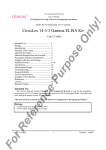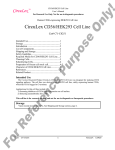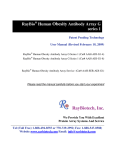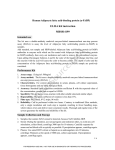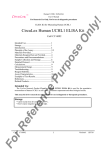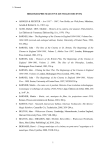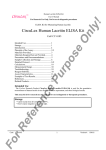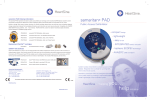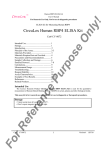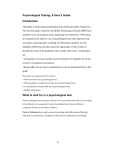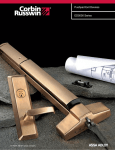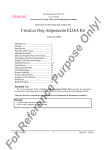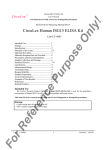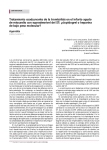Download For Reference Purpose Only!
Transcript
CircuLex Mouse FABP3/H-FABP ELISA Kit User’s Manual For Research Use Only, Not for use in diagnostic procedures ELISA Kit for Measuring Mouse FABP3/H-FABP On ly! TM CircuLex Mouse FABP3/H-FABP ELISA Kit ce Pu Intended Use................................................ 1 Storage......................................................... 1 Introduction.................................................. 2 Principle of the Assay.................................. 3 Materials Provided....................................... 4 Materials Required but not Provided........... 5 Precautions and Recommendations.............. 6 Sample Collection and Storage.....................7 Detailed Protocol........................................... 8-10 Calculations..................................…............ 10 Measurement Range.................................... 10 Troubleshooting........................................... 11 Reagent Stability.......................................... 11 Assay Characteristics................................... 12-13 Example of Test Results................................14 References.................................................... 14-15 Related Products........................................... 15 rp os e Cat# CY-8055 Intended Use en The CycLex Research Product CircuLex Mouse FABP3/H-FABP ELISA Kit is used for the quantitative measurement of mouse FABP3/H-FABP in serum, plasma and other biological media. This assay kit is for research use only and not for use in diagnostic or therapeutic procedures. Storage rR ef er • Upon receipt store all components at 4°C. • Don’t expose reagents to excessive light. Fo Cat#: CY-8055 1 Version#: 120710 CircuLex Mouse FABP3/H-FABP ELISA Kit User’s Manual For Research Use Only, Not for use in diagnostic procedures On ly! TM Introduction rp os e Fatty acid-binding proteins (FABPs) are a class of cytoplasmic proteins that bind long chain fatty acids. FABPs are small intracellular proteins (~13-14 kDa) with a high degree of tissue specificity. They are abundantly present in various cell types and play an important role in the intracellular utilization of fatty acids, transport and metabolism. There are at least nine distinct types of FABP, each showing a specific pattern of tissue expression. Fatty acid binding protein 3 (FABP3), also known as heart-type FABP (H-FABP), is highly expressed in heart and skeletal muscle. The level of FABP3/H-FABP was influenced by exercise, PPAR-α agonists and testosterone, and oscillates with circadian rhythm. In muscle cells, FABP3/H-FABP was involved in the uptake of fatty acids and their subsequent transport towards the mitochondrial β-oxidation system. Increased fatty-acid exposure in vitro and in vivo resulted in elevated FABP3/H-FABP expression. FABP3/H-FABP was first shown to be released from injured myocardium in 1988, after which several studies investigated its application as a biochemical marker of myocardial injury. The FABP3/H-FABP isoform is produced not only in cardiomyocytes but also, to a lesser extent, in skeletal muscle, distal tubular cells of the kidney, specific parts of the brain, lactating mammary glands, and placenta. Recently, FABP3/H-FABP was shown to be a sensitive biomarker for assessing skeletal muscle toxicity in rats. Principle of the Assay rR ef er en ce Pu The CircuLex Mouse FABP3/H-FABP ELISA Kit employs the quantitative sandwich enzyme immunoassay technique. An antibody specific for mouse FABP3/H-FABP has been pre-coated onto a microplate. Standards and samples are pipetted into the wells and the immobilized antibody binds any mouse FABP3/H-FABP present. After washing away any unbound substances, a biotinylated antibody specific for mouse FABP3/H-FABP is added to the wells, followed by binding with horseradish peroxidase (HRP) conjugated Streptavidin, which then catalyzes the conversion of the chromogenic substrate tetra-methylbenzidine (TMB) from a colorless solution to a blue solution (or yellow after the addition of stopping reagent). The reaction is stopped by addition of acidic solution and absorbance of the resulting yellow product is measured at 450 nm. The absorbance is proportional to the concentration of mouse FABP3/H-FABP. A standard curve is constructed by plotting absorbance values versus mouse FABP3/H-FABP concentrations of calibrators, and concentrations of unknown samples are determined using this standard curve. The CircuLex Mouse FABP3/H-FABP ELISA Kit is designed to measure the concentration of mouse FABP3/H-FABP from mouse serum/plasma and other biological media. Fo Cat#: CY-8055 2 Version#: 120710 CircuLex Mouse FABP3/H-FABP ELISA Kit User’s Manual For Research Use Only, Not for use in diagnostic procedures Summary of Procedure Add 100 µL of diluted sample to the wells Incubate for 1 hour at room temp. Wash the wells On ly! TM Add 100 µL of biotinylated anti-mouse FABP3/H-FABP antibody rp os e Incubate for 1hour at room temp. Wash the wells Add 100 µL of HRP conjugated Streptavidin Incubate for 20 minutes at room temp. Wash the wells Pu Add 100 µL of Substrate Reagent Add 100 µL of Stop Solution rR ef er en ce Measure absorbance at 450 nm Fo Cat#: CY-8055 3 Version#: 120710 CircuLex Mouse FABP3/H-FABP ELISA Kit User’s Manual For Research Use Only, Not for use in diagnostic procedures On ly! TM Materials Provided All samples and standards should be assayed in duplicate. The following components are supplied and are sufficient for the one 96-well microplate kit. Microplate: One microplate supplied ready to use, with 96 wells (12 strips of 8-wells) in a foil, zip-lock bag with a desiccant pack. Wells are coated with anti-mouse FABP3/H-FABP antibody as a capture antibody. rp os e 10X Wash Buffer: One bottle containing 100 mL of 10X buffer containing 2%Tween®-20 Dilution Buffer: One bottle containing 50 mL of 1X buffer; use for sample dilution. Ready to use. Mouse FABP3/H-FABP Standard: One vials containing 16 ng of lyophilized recombinant mouse FABP3/H-FABP Biotinylated Detection Antibody: One bottle containing 12 mL of biotinylated anti-mouse FABP3 /H-FABP antibody. Ready to use. HRP conjugated Streptavidin: One bottle containing 12 mL of HRP (horseradish peroxidase) conjugated streptavidin. Ready to use. Pu Substrate Reagent: One bottle containing 20 mL of the chromogenic substrate, tetra-methylbenzidine (TMB). Ready to use. rR ef er en ce Stop Solution: One bottle containing 20 mL of 1 N H2SO4. Ready to use. Fo Cat#: CY-8055 4 Version#: 120710 CircuLex Mouse FABP3/H-FABP ELISA Kit User’s Manual For Research Use Only, Not for use in diagnostic procedures On ly! TM Materials Required but not Provided • Pipettors: 2-20 µL, 20-200 µL and 200-1000 µL precision pipettors with disposable tips. • Precision repeating pipettor • Orbital microplate shaker • Microcentrifuge and tubes for sample preparation. rp os e • Vortex mixer • Microplate washer: optional (Manual washing is possible but not preferable) • Plate reader capable of measuring absorbance in 96-well plates at dual wavelengths of 450 nm/540 nm. Dual wavelengths of 450/550 or 450/595 nm can also be used. The plate can also be read at a single wavelength of 450 nm, which will give a somewhat higher reading. • Software package facilitating data generation and analysis :optional • Reagent reservoirs • Deionized water of the highest quality rR ef er en ce • Disposable paper towels Pu • 500 or 1000 mL graduated cylinder Fo Cat#: CY-8055 5 Version#: 120710 CircuLex Mouse FABP3/H-FABP ELISA Kit User’s Manual For Research Use Only, Not for use in diagnostic procedures Precautions and Recommendations • Allow all the components to come to room temperature before use. On ly! TM • All microplate strips that are not immediately required should be returned to the zip-lock pouch, which must be carefully resealed to avoid moisture absorption. • Do not use kit components beyond the indicated kit expiration date. rp os e • Use only the microtiter wells provided with the kit. • Rinse all detergent residue from glassware. • Use deionized water of the highest quality. • Do not mix reagents from different kits. • The buffers and reagents used in this kit contain NaN3 as preservatives. Care should be taken to avoid direct contact with these reagents. • Do not mouth pipette or ingest any of the reagents. Pu • Do not smoke, eat, or drink when performing the assay or in areas where samples or reagents are handled. • Dispose of tetra-methylbenzidine (TMB) containing solutions in compliance with local regulations. • Avoid contact with Substrate Solution which contains hydrogen peroxide. ce • Avoid contact with Stop Solution which contains Sulfuric Acid. en • Wear gloves and eye protection when handling immunodiagnostic materials and samples of human origin, and these reagents. In case of contact with the Stop Solution and the Substrate Solution, wash skin thoroughly with water and seek medical attention, when necessary. • Biological samples may be contaminated with infectious agents. Do not ingest, expose to open wounds or breathe aerosols. Wear protective gloves and dispose of biological samples properly. rR ef er • CAUTION: Sulfuric Acid is a strong acid. Wear disposable gloves and eye protection when handling Stop Solution. Fo Cat#: CY-8055 6 Version#: 120710 CircuLex Mouse FABP3/H-FABP ELISA Kit User’s Manual For Research Use Only, Not for use in diagnostic procedures On ly! TM Sample Collection and Storage Serum: Use a serum separator tube and allow samples to clot for 60 ± 30 minutes. Centrifuge the samples at 4°C for 10 minutes at 1,000 x g. Remove serum and assay immediately or store samples on ice for up to 6 hours before assaying. Aliquots of serum may also be stored at below -70°C for extended periods of time. Avoid repeated freeze-thaw cycles. rp os e Plasma: Collect plasma using EDTA-2Na or heparin as the anticoagulant. If possible, collect the plasma into a mixture of EDTA-2Na and Futhan5 to stabilize the sample against spontaneous in vitro complement activation. Immediately centrifuge samples at 4°C for 15 minutes at 1,000 x g. Assay immediately or store samples on ice for up to 6 hours before assaying. Aliquots of plasma may also be stored at below -70°C for extended periods of time. Avoid repeated freeze-thaw cycles. Note: Citrate plasma has not been validated for use in this assay. Urine: Immediately centrifuge samples at 4°C for 15 minutes at 15,000 x g. Assay immediately the supernatant or store on ice for up to 24 hours before assaying. Aliquots of urine may also be stored at below -70°C for extended periods of time. Avoid repeated freeze-thaw cycles. rR ef er en ce Pu Other biological samples: Remove any particulates by centrifugation and assay immediately or aliquot and store samples at below -70°C. Avoid repeated freeze-thaw cycles. Fo Cat#: CY-8055 7 Version#: 120710 CircuLex Mouse FABP3/H-FABP ELISA Kit User’s Manual For Research Use Only, Not for use in diagnostic procedures On ly! TM Detailed Protocol The CycLex Research Product CircuLex Mouse FABP3/H-FABP ELISA Kit is provided with removable strips of wells so the assay can be carried out on separate occasions using only the number of strips required for the particular determination. Since experimental conditions may vary, an aliquot of the mouse FABP3/H-FABP Standard within the kit, should be included in each assay as a calibrator. Disposable pipette tips and reagent troughs should be used for all liquid transfers to avoid cross-contamination of reagents or samples. Preparation of Working Solutions rp os e All reagents need to be brought to room temperature prior to the assay. Assay reagents are supplied ready-to-use, with the exception of 10X Wash Buffer and Mouse FABP3/H-FABP Standard. 1. Prepare a working solution of Wash Buffer by adding 100 mL of the 10X Wash Buffer to 900 mL of deionized (distilled) water (ddH2O). Mix well. Store at 4°C for two weeks or -20°C for long-term storage. 2. Reconstitute Mouse FABP3/H-FABP Standard with 1.0 mL of ddH2O. The concentration of the mouse FABP3/H-FABP in vial should be 16 ng/mL, which is referred as a Master Standard of mouse FABP3/H-FABP. Pu Prepare Standard Solutions as follows: Use the Master Standard to produce a dilution series (below). Mix each tube thoroughly before the next transfer. The 4,000 pg/mL standard (Std.1) serves as the highest standard. The Dilution Buffer serves as the zero standard (Blank). Volume of Standard 150 µL of Master Standard 300 µL of Std. 1 (4,000 pg/mL) 300 µL of Std. 2 (2,000 pg/mL) 300 µL of Std. 3 (1,000 pg/mL) 300 µL of Std. 4 (500 pg/mL) 300 µL of Std. 5 (250 pg/mL) 300 µL of Std. 6 (125 pg/mL) en ce Std.1 Std.2 Std.3 Std.4 Std.5 Std.6 Std.7 Blank - Dilution Buffer 450 µL 300 µL 300 µL 300 µL 300 µL 300 µL 300 µL 300 µL Concentration 4,000 pg/mL 2,000 pg/mL 1,000 pg/mL 500 pg/mL 250 pg/mL 125 pg/mL 62.5 pg/mL 0 pg/mL er Note: Do not use a Repeating pipette. Change tips for every dilution. Wet tip with Dilution Buffer before dispensing. Unused portions of Master Standard should be aliquoted and stored at below -70 °C immediately. Avoid multiple freeze and thaw cycles. ef Sample Preparation • Serum and plasma samples usually require a 50-fold dilution with Dilution Buffer. e.g. 6 µL of sample + 294 µL of Dilution Buffer rR • Other biological samples require 10- and 100- and 400- fold dilution or appropriate dilution. Fo Cat#: CY-8055 8 Version#: 120710 CircuLex Mouse FABP3/H-FABP ELISA Kit User’s Manual For Research Use Only, Not for use in diagnostic procedures On ly! TM Note-1: Please predict the concentration before carrying out assay. If values for these are not within the range of the standard curve, users must determine the optimal sample dilutions for their particular experiments. Note-2: Dilutions lower than 10-fold should not be used. Assay Procedure rp os e 1. Prepare the assay protocol, assigning the appropriate wells for setting up Standard solutions, diluted patient specimens and any internal laboratory controls in duplicate. Remove the appropriate number of microtiter wells from the foil pouch and place them into the well holder. Return any unused wells to the foil pouch, refold, seal with tape and store at 4°C. 2. Dilute samples with Dilution Buffer. (See “Sample Preparation” above.) 3. Pipette 100 µL of Standard Solutions (Std1-Std7, Blank) and diluted samples in duplicates, into the appropriate wells. 4. Incubate the plate at room temperature (ca.25°C) for 1 hour, shaking at ca. 300 rpm on an orbital microplate shaker. Pu 5. Wash 4-times by filling each well with Wash Buffer (350 µL) using a squirt bottle, multi-channel pipette, manifold dispenser or microplate washer. 6. Add 100 µL of Biotinylated Detection Antibody into each well. 7. Incubate the plate at room temperature (ca.25°C) for 1 hour, shaking at ca. 300 rpm on an orbital microplate shaker. ce 8. Wash 4-times by filling each well with Wash Buffer (350 µL) using a squirt bottle, multi-channel pipette, manifold dispenser or microplate washer. 9. Add 100 µL of HRP conjugated Streptavidin into each well. en 10. Incubate the plate at room temperature (ca.25°C) for 20 minutes, shaking at ca. 300 rpm on an orbital microplate shaker. er 11. Wash 4-times by filling each well with Wash Buffer (350 µL) using a squirt bottle, multi-channel pipette, manifold dispenser or microplate washer. 12. Add 100 µL of Substrate Reagent. Avoid exposing the microtiter plate to direct sunlight. Covering the plate with e.g. aluminum foil is recommended. Return Substrate Reagent to 4°C immediately after the necessary volume is removed rR ef 13. Incubate the plate at room temperature (ca. 25°C) for 10-20 minutes, shaking at ca. 300 rpm on an orbital microplate shaker. The incubation time may be extended up to 30 minutes if the reaction temperature is below than 20°C. 14. Add 100 µL of Stop Solution to each well in the same order as the previously added Substrate Reagent. Fo Cat#: CY-8055 9 Version#: 120710 TM On ly! CircuLex Mouse FABP3/H-FABP ELISA Kit User’s Manual For Research Use Only, Not for use in diagnostic procedures 15. Measure absorbance in each well using a spectrophotometric microplate reader at dual wavelengths of 450/540 nm. Dual wavelengths of 450/550 or 450/595 nm can also be used. Read the microplate at 450 nm if only a single wavelength can be used. Wells must be read within 30 minutes of adding the Stop Solution. rp os e Note-1: Complete removal of liquid at each step is essential to good performance. After the last wash, remove any remaining Wash Buffer by aspirating or decanting. Invert the plate and blot it against clean paper towels. Note-2: Reliable standard curves are obtained when either O.D. values do not exceed 0.2 units for the blank (zero concentration), or 2.5 units for the highest standard concentration. The plate should be monitored at 5-minute intervals for approximately 30 minutes. Note-3: If the microplate reader is not capable of reading absorbance greater than the absorbance of the highest standard, perform a second reading at 405 nm. A new standard curve, constructed using the values measured at 405 nm, is used to determine mouse FABP3/H-FABP concentration of off-scale samples. The readings at 405 nm should not replace the on-scale readings at 450 nm. Calculations Pu Average the duplicate readings for each standard, control, and sample and subtract the average zero standard optical density. Plot the optical density for the standards versus the concentration of the standards and draw the best curve. To determine the mouse FABP3/H-FABP concentration of each sample, first find the absorbance value on the y-axis and extend a horizontal line to the standard curve. At the point of intersection, extend a vertical line to the x-axis and read the corresponding mouse FABP3/H-FABP concentration. If the samples have been diluted, the concentration read from the standard curve must be multiplied by the dilution factor. ce 1. The results of unknown samples can be calculated with any computer program having a 5-parameter logistic function. It is important to make an appropriate mathematical adjustment to accommodate for the dilution factor. en 2. Most microtiter plate readers perform automatic calculations of analyte concentration. The calibration curve is constructed by plotting the absorbance (Y) of calibrators versus log of the known concentration (X) of calibrators, using the four-parameter function. Alternatively, the logit log function can be used to linearize the calibration curve (i.e. logit of absorbance (Y) is plotted versus log of the known concentration (X) of calibrators). er 3. Dilution factors need to be taken into consideration in calculating the mouse FABP3/H-FABP concentration. Measurement Range rR ef The measurement range is 62.5 pg/mL to 4,000 pg/mL. Any sample reading higher than the highest standard should be diluted with Dilution Buffer in higher dilution and re-assayed. Dilution factors need to be taken into consideration in calculating the mouse FABP3/H-FABP concentration. Fo Cat#: CY-8055 10 Version#: 120710 CircuLex Mouse FABP3/H-FABP ELISA Kit User’s Manual For Research Use Only, Not for use in diagnostic procedures On ly! TM Troubleshooting 1. Standards should be run in duplicate, using the protocol described in the Detailed Protocol. Incubation times or temperatures significantly different from those specified may give erroneous results. 2. Poor duplicates, accompanied by elevated values for wells containing no sample, indicate insufficient washing. If all instructions in the Detailed Protocol were followed accurately, such results indicate a need for washer maintenance. rp os e 3. Overall low signal may indicate that desiccation of the plate has occurred between the final wash and addition of Substrate Reagent. Do not allow the plate to dry out. Add Substrate Reagent immediately after wash. Reagent Stability rR ef er en ce Pu All of the reagents included in the CycLex Research Product CircuLex Mouse FABP3/H-FABP ELISA Kit have been tested for stability. Reagents should not be used beyond the stated expiration date. Upon receipt, kit reagents should be stored at 4°C, except the reconstituted mouse FABP3/H-FABP Standard must be stored at below -70°C. Coated assay plates should be stored in the original foil bag sealed by the zip lock and containing a desiccant pack. Fo Cat#: CY-8055 11 Version#: 120710 CircuLex Mouse FABP3/H-FABP ELISA Kit User’s Manual For Research Use Only, Not for use in diagnostic procedures On ly! TM Assay Characteristics 1. Sensitivity The limit of detection (defined as such a concentration of mouse FABP3/H-FABP giving absorbance higher than mean absorbance of blank* plus three standard deviations of the absorbance of blank: A blank + 3SD blank) is better than 19.51 pg/ml of sample. 2. Precision rp os e * Dilution Buffer is pipetted into blank wells. Intra-assay Precision (Precision within an assay) Three samples of known concentration were tested sixteen times on one plate to assess intra-assay precision. • Intra-assay (Within-Run, n=16) CV=4.5, 5.0, 6.9 % rR ef Fo Cat#: CY-8055 Pu Mouse FABP 3 conc. (ng/ml) Serum 2 Serum 3 50.26 10.64 50.34 10.58 51.59 10.05 50.53 9.93 47.99 10.36 51.28 10.36 53.18 11.08 56.07 9.45 48.22 10.01 48.14 10.06 47.46 9.00 47.93 8.95 47.39 8.86 49.63 9.13 53.03 9.24 52.90 9.91 56.07 11.08 47.39 8.86 50.37 9.85 2.52 0.68 5.0% 6.9% ce er en 1 2 3 4 5 6 7 8 9 10 11 12 13 14 15 16 MAX. MIN. MEAN S.D. C.V. Serum 1 98.85 95.03 89.44 90.46 88.30 89.71 95.42 93.18 94.02 93.98 87.85 84.83 85.57 87.08 96.26 93.24 98.85 84.83 91.45 4.12 4.5% 12 Version#: 120710 CircuLex Mouse FABP3/H-FABP ELISA Kit User’s Manual For Research Use Only, Not for use in diagnostic procedures On ly! TM Inter-assay Precision (Precision between assays) Three samples of known concentration were tested in four separate assays to assess inter-assay precision. • Inter-assay (Run-to-Run, n=4) CV=9.2, 4.4, 4.8% Mouse FABP 3 conc. (ng/ml) 1 2 3 4 MAX. MIN. MEAN S.D. C.V. Serum 2 57.3 59.0 58.7 53.5 59.0 53.5 57.1 2.53 4.43% Serum 3 11.5 12.6 12.8 12.5 12.8 11.5 12.3 0.59 4.80% rp os e Serum 1 92.3 102.0 115.5 105.4 115.5 92.3 103.8 9.55 9.20% 3. Linearity Pu To assess the linearity of the assay, samples containing and/or spiked with high concentrations of mouse FABP3/H-FABP were serially diluted with the Dilution Buffer to produce samples with values within the dynamic range of the assay. Linearity ce ● Serum 1 ▲ Serum 2 ◆ Serum 3 1.5 1.0 en 2.0 er Mouse FABP 3 conc. (ng/ml) 2.5 ef 0.5 0.0 rR 0 Fo Cat#: CY-8055 0.5 1 1.5 2 2.5 Serum Dilution Ratio (1/100) 13 Version#: 120710 CircuLex Mouse FABP3/H-FABP ELISA Kit User’s Manual For Research Use Only, Not for use in diagnostic procedures On ly! TM Example of Test Results Fig.1 Typical standard curve Mouse FABP 3 Standard Curve 2.0 rp os e A450 1.5 1.0 0.5 Pu 0.0 0 1 2 Standard conc. (ng/ml) 4 ce References 3 1. Furuhashi M. and Hotamisligil GS.; Fatty acid-binding proteins: role in metabolic diseases and potential as drug targets. Nat Rev Drug Discov. 7: 489, 2008 en 2. Chmurzynska A.; The multigene family of fatty acid-binding proteins (FABPs): function, structure and polymorphism. J Appl Genet., 47: 39-48, 2006 3. Storch J. and B Corsico B.; The emerging functions and mechanisms of mammalian fatty acid-binding proteins. Annu Rev Nutr., 28: 73-95, 2008 er 4. Sato Y, Kita T, Takatsu Y, Kimura T.; Biochemical markers of myocyte injury in heart failure. Heart., 90: 1110-3, 2004 ef 5. O'Donoghue M, de Lemos JA, Morrow DA, Murphy SA, Buros JL, Cannon CP, Sabatine MS.; Prognostic utility of heart-type fatty acid binding protein in patients with acute coronary syndromes. Circulation., 114: 550-7, 2006 rR 6. McCann CJ, Glover BM, Menown IB, Moore MJ, McEneny J, Owens CG, Smith B, Sharpe PC, Young IS, Adgey JA.; Novel biomarkers in early diagnosis of acute myocardial infarction compared with cardiac troponin T. Eur Heart J., 29: 2843-50, 2008 Fo Cat#: CY-8055 14 Version#: 120710 CircuLex Mouse FABP3/H-FABP ELISA Kit User’s Manual For Research Use Only, Not for use in diagnostic procedures On ly! TM 7. Azzazy HM, Pelsers MM, Christenson RH.; Unbound free fatty acids and heart-type fatty acid-binding protein: diagnostic assays and clinical applications. Clin Chem. 52: 19-29, 2006 8. Pritt ML, Hall DG, Recknor J, Credille KM, Brown DD, Yumibe NP, Schultze AE, Watson DE.; Fabp3 as a Biomarker of Skeletal Muscle Toxicity in the Rat: Comparison with Conventional Biomarkers Toxicol. Sci,. 103: 382-396, 2008 Related Products PRODUCED BY er en CycLex Co., Ltd. 1063-103 Terasawaoka Ina, Nagano 396-0002 Japan Fax: +81-265-76-7618 e-mail: [email protected] URL: http://www.cyclex.co.jp ce Pu rp os e * CircuLex Mouse FABP1/L-FABP ELISA Kit: Cat# CY-8054 * CircuLex Mouse FABP3/H-FABP ELISA Kit: Cat# CY-8055 * CircuLex Mouse FABP5/E-FABP/mal1 ELISA Kit: Cat# CY-8056 * CircuLex Mouse FABP4/A-FABP ELISA Kit: Cat# CY-8077 * CircuLex Rat FABP4/A-FABP ELISA Kit: Cat# CY-8076 * CircuLex Mouse NGAL ELISA Kit: Cat# CY-8053 * CircuLex Human NGAL ELISA Kit: Cat# CY-8070 * CircuLex Rat Adiponectin ELISA Kit: Cat# CY-8049 * CircuLex Mouse Adiponectin ELISA Kit: Cat# CY-8051 * CircuLex Human Adiponectin ELISA Kit: Cat# CY-8050 * CircuLex S100A12/EN-RAGE ELISA Kit: Cat# CY-8058 * CircuLex S100A4 ELISA Kit: Cat# CY-8059 * CircuLex S100P ELISA Kit: Cat# CY-8060 * CircuLex S100A8 ELISA Kit: Cat# CY-8061 * CircuLex S100A9 ELISA Kit: Cat# CY-8062 * CircuLex S100A7 (psoriasin) ELISA Kit: Cat# CY-8073 * CircuLex CML/Nε-(carboxymethyl) Lysine ELISA Kit: Cat# CY-8066 * CircuLex High-Sesitivity CRP ELISA Kit: Cat# CY-8071 rR ef CycLex/CircuLex products are supplied for research use only. CycLex/CircuLex products and components thereof may not be resold, modified for resale, or used to manufacture commercial products without prior written approval from CycLex Co., Ltd.. To inquire about licensing for such commercial use, please contact us via email. Fo Cat#: CY-8055 15 Version#: 120710


















